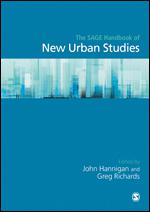The SAGE Handbook of New Urban Studies

This is a follow-up to the 2001 Handbook of Urban Studies, and shows the increasingly multidisciplinary nature of scholarship that falls under the urban studies label. The editors explain in the introduction that they deliberately avoided a linear approach to editing this collection. So the original papers collected here are about anything and everything, including different theories (e.g. assemblage theory), topics (e.g. sports mega-events), and of course places (e.g. one unusual chapter comparing Hartford, Connecticut with Zanzibar, Tanzania).
A chapter on territorial stigmatization explores how language and sentiment are deployed to mark off certain urban spaces as toxic. One example is a think tank report claiming that London’s tower blocks are dehumanizing and make residents more prone to depression and suicide. Author Tom Slater takes issue with what he calls “symbolic defamation”, which refers in inflammatory terms to a culture of poverty and disorder. This is problematic not just in itself, but because such stigmatization has negative real-world consequences for the people associated with stigmatized places. For example, educational prospects are limited for Swedish students who are known to live in certain immigrant suburbs. Officials are also less likely to invest city resources in areas that they have an ideological and political justification for neglecting.
A chapter by Bill Randolph analyses the reversal of the spatial patterns of advantage that were prominent just a few decades ago, as the poor in the US, UK and Australia are increasingly found not in inner cities, but in suburbs. This trend is linked to the increasing investment in and valorization of central urban spaces, by city officials, property developers, and affluent young people. Especially in the US, the now ageing homes and infrastructure of inner and middle suburbs built after World War II are increasingly home to ethnic minorities, immigrants, and low-income people. Being located far from jobs and government offices appears likely to only entrench the disadvantage of these groups.
The editors comment:
“Chicago and Manchester are synonymous with classic theories of the industrial city of the late nineteenth century; Los Angeles is the template for the post-modern city of the late twentieth century; and Shanghai is a poster child for twenty-first century urban modernity.”
The chapters in this handbook take readers through all of these currents in thinking about the city. From this overview, the literature appears to be increasingly decentralized and increasingly interested in low- and middle-income nations.
Further reading:
Environment and Urbanization (1995), “Urban poverty II: from understanding to action”, Vol 7, No 2, available at http://journals.sagepub.com/toc/eaua/7/2.
Environment and Urbanization (2016), “From the MDGs to the SDGs and Habitat III”, Vol 28, No 1, available at http://journals.sagepub.com/toc/eaua/28/1.
Book note prepared by Christine Ro
Search the Book notes database
Our Book notes database contains details and summaries of all the publications included in Book notes since 1993 - with details on how to obtain/download.
Use the search form above, or visit the Book notes landing page for more options and latest content.
For a searchable database for papers in Environment and Urbanization, go to http://eau.sagepub.com/

